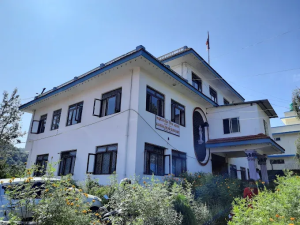Bagmati Province
Religious leaders and local authorities oppose Kaligandaki-Tinau Diversion Multipurpose Project
The project is expected to affect the lives of around 300,000 people from 10 local units of Tanahun, Nawalparasi (East) and Syangja.
Ramesh Kumar Paudel
Religious leaders of the Devghat area (in Chitwan) have protested against the government’s plan of diverting the Kaligandaki river into the Tinau river.
The Devghat Area Development Committee, Nepal Santa Samaj and Devghat Rural Municipality of Tanahun jointly organised a programme in Bharatpur, Chitwan, on Monday to discuss the impact of the Kaligandaki-Tinau Diversion Multipurpose Project. Four different papers on the multi-billion project were presented at the programme.
The project envisions to irrigate around 106,000 hectares of land in Rupandehi and Kapilvastu districts and produce 104 MW electricity by diverting the water of the Kaligandaki river to the Tinau through a 30-kilometre long tunnel. The estimated cost of the project is around Rs 45 billion.
But locals claim that the multi-purpose project would greatly affect the ecosystem of the place, its population and even the existence of Devghat—a revered place for Hindu pilgrims.
Presenting his paper, Swami Chaitanya Krishna, the chairman of Kaligandaki Gyan Bigyan Pratishthan, said the diversion project stands to ruin the area’s ecosystem. “The Kaligandaki river, which has deep cultural and religious significance, should not be disturbed in the name of irrigating land and generating hydroelectricity,” said Krishna, urging the government to not pursue the project. “It is a civilisation in itself. Any act of disturbing the river greatly affects Devghat and Tribeni.”
The government has even allocated a budget to prepare a detailed project report of the project. The project aims to divert the water of the Kaligandaki river from Ramdighat of Syangja to the Tinau river.
According to Shanta Bahadur Shrestha, a former government secretary, after the completion of the project, the water flow of the Kaligandaki river will be decreased by 40 percent, which will affect around 300,000 people from 10 local units of Tanahun, Nawalparasi (East) and Syangja.
“There is comparatively less rainfall in the Mahabharat area below Ramdi. If the project is implemented, there will be a decrease in the water flow in the river which will result in a drier riverbank,” said Shrestha. He added that 80 percent of arable land in Rupandehi and Kapilvastu already have irrigation facilities and providing more water to the areas should not be a point of focus of the government, especially considering the consequences such a hazardous move will bring on the areas in the downstream of Ramdi.
The programme was chaired by Kiran Gurung, Minister of Economic Affairs and Planning of Gandaki Province. Speaking at the programme, Minister Gurung asserted that the Gandaki Province too was against the project. Chiefs of three Ashrams—Galeshwor, Mahesh Sanyas and Harihar—attended the function.
Guru Prasad Subedi, general secretary of Nepal Santa Samaj, said the diversion project would ruin the religious importance of Ramdi, Keladi and Devghat. “Kaligandaki is not only a river, but it is also home to Devghat which goes as far back as the Vedic civilisation,” he added.
Kulraj Chalise, who completed his PhD thesis on the Kaligandaki river, said, “The multipurpose project is not suitable because it has a possible negative impact on the underground water and ecosystem.”
Earlier, Chief Minister of Gandaki Province Prithvi Subba Gurung had said he would not let the federal government carry out the project at any cost, as the Kaligandaki, which is considered a holy river for Hindu people, flows through Gandaki Province, before emptying into the Trishuli river at Devghat.




 16.24°C Kathmandu
16.24°C Kathmandu1.jpg)














